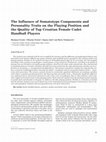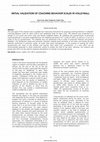Papers by Mario Tomljanovic

Biology of Sport, Mar 1, 2015
The aim of the present study was to compare the effects of different warm-up interventions on jum... more The aim of the present study was to compare the effects of different warm-up interventions on jump, sprint and agility performance in collegiate soccer players. Twenty-one healthy male college soccer players (age: 20.14 ± 1.65 years; body height: 179.9 ± 8.34 cm; body mass: 74.4 ± 13.0 kg; % body fat: 9.45 ± 4.8) participated in the study. Subjects underwent four different randomized warm-up protocols separated by at least 48 hours. The warm-up schemes were: 1. no conditioning contraction protocol (NCC); 2. dynamic stretching (DS); 3. prolonged intermittent low-intensity isometric exercise (ST); and, 4. ST with an additional external load equal to 30% of body weight (ST + 30% BW). All interventions were preceded by a general warm-up. Results from one-way repeated measures ANOVA demonstrated a significant difference in countermovement jump (CMJ) at F(3,60)=10.2, ηρ²=0.337, p<0.01. Post hoc analysis revealed a significant difference in CMJ performance in DS when compared to NCC and...

The purpose of this study was to compare the effects of loaded whole body static squat exercise d... more The purpose of this study was to compare the effects of loaded whole body static squat exercise during whole body vibration and non-vibration schemes on countermovement jump (CMJ), speed and agility. Twenty-one healthy male college football players (age: 20.14 ± 1.65 years; body height: 179.9 ± 8.34 cm; body mass: 74.4 ± 13.0 kg; % body fat: 9.45 ± 4.8) participated in the study. They underwent a standardized general warm-up and dynamic stretching followed by randomized loaded protocols executed for 5 minutes with a rest interval of 30 seconds. These included static squat with 30% bodyweight external load (ST + 30%), ST + 30% on a vibration platform at 25 Hz and 2 mm (WBV25), and ST + 30% on a vibration platform at 50 Hz and 4mm. Measurement of CMJ, 15 m sprint and modified agility tests followed the warm-up protocol. One way repeated measures ANOVA revealed a significant difference on CMJ performance, F(2,40) = 24.5, partial η2 = .551, p < 0.01. Bonferonni post hoc showed that S...

Collegium Antropologicum, May 23, 2013
The research was conducted with the aim to establish the structure and the differences of morphol... more The research was conducted with the aim to establish the structure and the differences of morphological features and personality traits between different age groups of female cadet handball players grouped by their playing quality and playing positions. Further on, the research was done on 70 handball players aged 15, 31 on average, who were grouped according to their positions on goalkeepers, outside players, wings and pivots. Furthermore, according to the quality of playing, they were divided in two quality groups of players, those from the wider cadet national team, thus characterised as top female players in Croatia, and those who had never been invited into the cadet national team and thus can be referred to as low-quality, i.e. average female handball players. The structure of predictor variables has indicated the existence of general morphological factor assessing the players' constitution and two personality features factors-neuroticism and extraversion. The variance analysis showed no statistically significant differences of somatotype variables with relation to quality and playing position. By observing basic personality traits, a statistically significant difference was confirmed only in introversion-extraversion with a lower score in goalkeepers than in other positions, which indicates a higher level of introversion in this playing position. Such result was expected since this particular position abounds in specific tasks and demands in the game in relation to all other playing positions. Further on, it has been concluded that the selection of players must not be based only on the stated physical and psychological characteristics, but on relevant anthropological complexes determining performance and sport achievement.
Frontiers in Sports and Active Living

Sport Scientific and Practical Aspects, May 23, 2013
Original scientific paper The main goal of this research was to validate two measuring instrument... more Original scientific paper The main goal of this research was to validate two measuring instruments for assessing coaching behavior in volleyball: Coaching Behavior Scale for Sport (CBS-S) and Leadership Scale for Sport (LSS). The research was conducted on a sample of 273 youth and junior male and female volleyball players. By validating the questionnaires of perceived coaching behavior it has been established that the reliability was good in all 7 scales of CBS-S, as well as in 3 out of 5 scales of the LLS questionnaire. The reliability was not satisfactory only in scales of autocratic behavior and positive feedback. The distribution shape and symmetry indicators indicate good sensitivity of all scales, and having the item selection performed in particular scales, all scales have good homogeneity. In the process of making the CBS-S questionnaire the views of top athletes and coaches were taken into consideration. It is why CBS-S can be recommended especially to those researchers willing to analyze the field of top sport. However, this research also proves that CBS-S can be used for assessing the behavior of coaches of young age groups.

The aim of the study was to determine differences in morphological characteristics (body height ,... more The aim of the study was to determine differences in morphological characteristics (body height , body weight, body mass index) among female students who engaged in different specific kinesiology activity. The study included 2849 students of undergraduate studies at the University of Split, ages 19-25 years. Data collection of the morphological characteristics (height, weight, body mass index) was determined by student clinics in Split competence of physicians, while the psychological characteristics were collected by the Rosenberg self-esteem scale, which consisted of 10 items. Physical education engagement was conducted through three sub-variables: sports, recreation and walking. Differences in the quantitative values were determined by univariate and multivariate analysis of variation. The values of these methods were defined with error p< 0.05. The results showed a statistically significant difference in height (p= 0.04), weight (p= 0.00) and level of self-esteem (p= 0.00) between the various kinesiology student engagement, while no statistically significant differences were given in the variable index of body weight (p = 0.88). Students who were more kinesiology engaged had an average greater height of the body (AS 170.22 cm), greater weight (AS 63.4 kg), which can be attributed to a greater height and a greater amount of muscle mass due to kinesiology engagement. The research showed no statistically significant differences between body mass index and variable "sports" (p= 0.26), "dealing with recreation" (p= 0.078), and "practicing walking" (p= 0.30). In conclusion, physical activity has an irreplaceable instrumental value, because it represents the best means of achieving and maintaining optimal body weight regulation of body mass index, and selfactualization in one of the aspects of dealing with a particular kinesiology activity to promote health and longevity of life.

The purpose of this study was to compare the effects of loaded whole body static squat exercise d... more The purpose of this study was to compare the effects of loaded whole body static squat exercise during whole body vibration and non-vibration schemes on countermovement jump (CMJ), speed and agility. Twenty-one healthy male college football players (age: 20.14 ± 1.65 years; body height: 179.9 ± 8.34 cm; body mass: 74.4 ± 13.0 kg; % body fat: 9.45 ± 4.8) participated in the study. They underwent a standardized general warm-up and dynamic stretching followed by randomized loaded protocols executed for 5 minutes with a rest interval of 30 seconds. These included static squat with 30% bodyweight external load (ST + 30%), ST + 30% on a vibration platform at 25 Hz and 2 mm (WBV25), and ST + 30% on a vibration platform at 50 Hz and 4mm. Measurement of CMJ, 15 m sprint and modified agility tests followed the warm-up protocol. One way repeated measures ANOVA revealed a significant difference on CMJ performance, F(2,40) = 24.5, partial η2 = .551, p < 0.01. Bonferonni post hoc showed that S...

Collegium antropologicum, 2013
The research was conducted with the aim to establish the structure and the differences of morphol... more The research was conducted with the aim to establish the structure and the differences of morphological features and personality traits between different age groups of female cadet handball players grouped by their playing quality and playing positions. Further on, the research was done on 70 handball players aged 15, 31 on average, who were grouped according to their positions on goalkeepers, outside players, wings and pivots. Furthermore, according to the quality of playing, they were divided in two quality groups of players, those from the wider cadet national team, thus characterised as top female players in Croatia, and those who had never been invited into the cadet national team and thus can be referred to as low-quality, i.e. average female handball players. The structure of predictor variables has indicated the existence of general morphological factor assessing the players' constitution and two personality features factors - neuroticism and extraversion. The variance a...

Biology of Sport, 2014
Warm-up: intermittent low intensity isometric protocols INTRODUCTION Warm-up is generally promote... more Warm-up: intermittent low intensity isometric protocols INTRODUCTION Warm-up is generally promoted as an ergogenic activity that is believed to assist athletes achieve their full physical potential in training or competition [1,2]. Warm-up raises body temperature, increases nerve conduction velocity, elevates muscle enzyme activity, and augments dilation of blood vessels that provide blood flow for better muscle oxidation during work. The aforementioned physiological mechanisms facilitate greater muscle force and power production [3,4], which are important in team sports requiring acceleration, deceleration, or change of direction [5]. Coaches use different warm-up conditions [6,7,8,9]. Recent studies suggest that aerobic warm-up and dynamic stretching are beneficial for sprint, jump, and agility tasks [1,6,8,10,11]. On the other hand, static stretching schemes with intensity at or above a point of discomfort or used with duration not longer than 45 s are scrutinized in performance settings for delivering detrimental effects [12,13]. Con

Original scientific paper The main goal of this research was to validate two measuring instrument... more Original scientific paper The main goal of this research was to validate two measuring instruments for assessing coaching behavior in volleyball: Coaching Behavior Scale for Sport (CBS-S) and Leadership Scale for Sport (LSS). The research was conducted on a sample of 273 youth and junior male and female volleyball players. By validating the questionnaires of perceived coaching behavior it has been established that the reliability was good in all 7 scales of CBS-S, as well as in 3 out of 5 scales of the LLS questionnaire. The reliability was not satisfactory only in scales of autocratic behavior and positive feedback. The distribution shape and symmetry indicators indicate good sensitivity of all scales, and having the item selection performed in particular scales, all scales have good homogeneity. In the process of making the CBS-S questionnaire the views of top athletes and coaches were taken into consideration. It is why CBS-S can be recommended especially to those researchers wil...

Uploads
Papers by Mario Tomljanovic